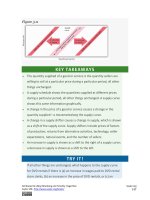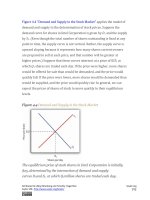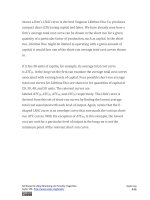Authors libby rittenberg 159
Bạn đang xem bản rút gọn của tài liệu. Xem và tải ngay bản đầy đủ của tài liệu tại đây (414.8 KB, 1 trang )
Demand shifters that could reduce the demand for coffee include a shift in
preferences that makes people want to consume less coffee; an increase in
the price of a complement, such as doughnuts; a reduction in the price of a
substitute, such as tea; a reduction in income; a reduction in population;
and a change in buyer expectations that leads people to expect lower
prices for coffee in the future.
An Increase in Supply
An increase in the supply of coffee shifts the supply curve to the right, as
shown in Panel (c) ofFigure 3.17 "Changes in Demand and Supply". The
equilibrium price falls to $5 per pound. As the price falls to the new
equilibrium level, the quantity of coffee demanded increases to 30 million
pounds of coffee per month. Notice that the demand curve does not shift;
rather, there is movement along the demand curve.
Possible supply shifters that could increase supply include a reduction in
the price of an input such as labor, a decline in the returns available from
alternative uses of the inputs that produce coffee, an improvement in the
technology of coffee production, good weather, and an increase in the
number of coffee-producing firms.
A Decrease in Supply
Panel (d) of Figure 3.17 "Changes in Demand and Supply" shows that a
decrease in supply shifts the supply curve to the left. The equilibrium price
rises to $7 per pound. As the price rises to the new equilibrium level, the
quantity demanded decreases to 20 million pounds of coffee per month.
Attributed to Libby Rittenberg and Timothy Tregarthen
Saylor URL: />
Saylor.org
159









